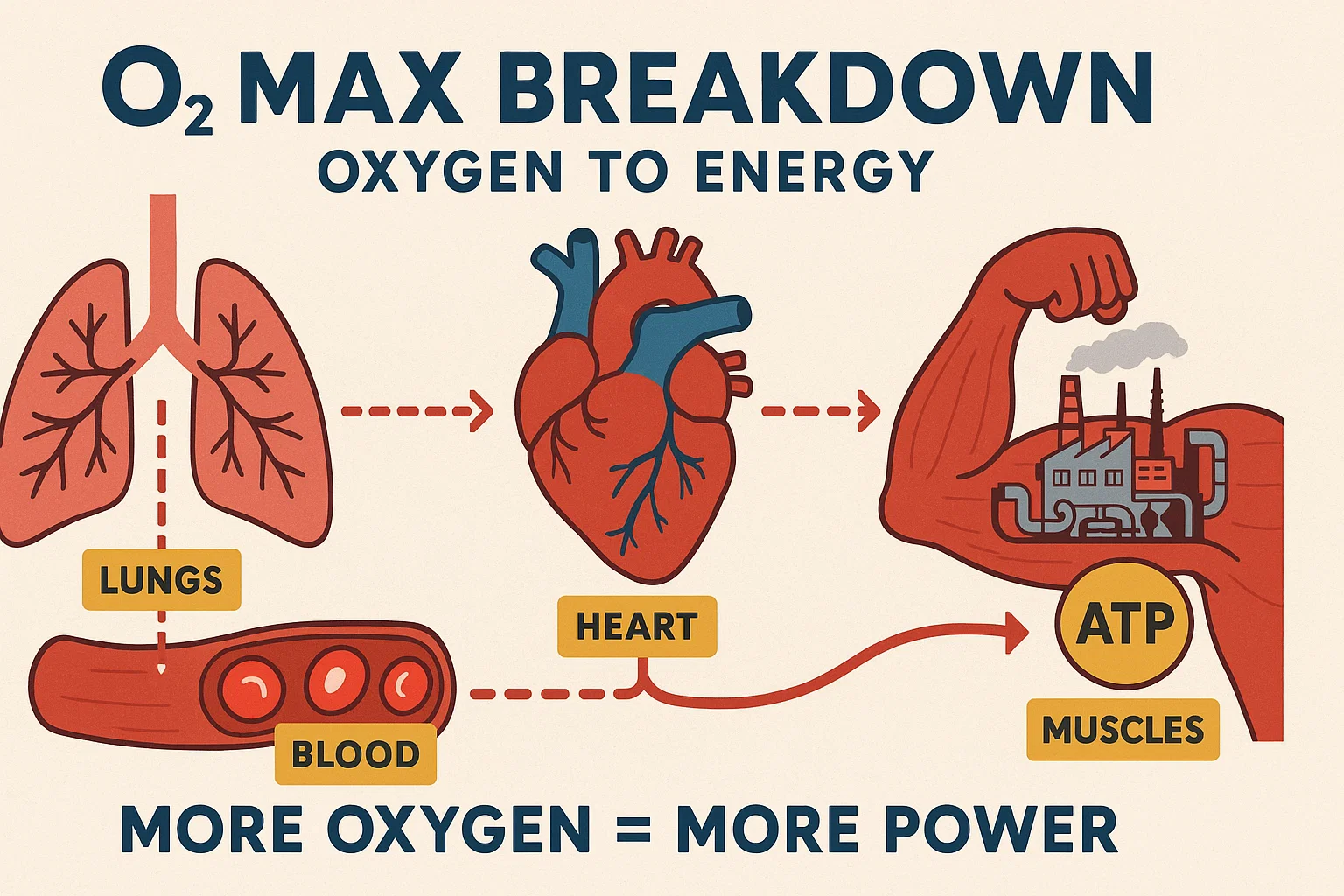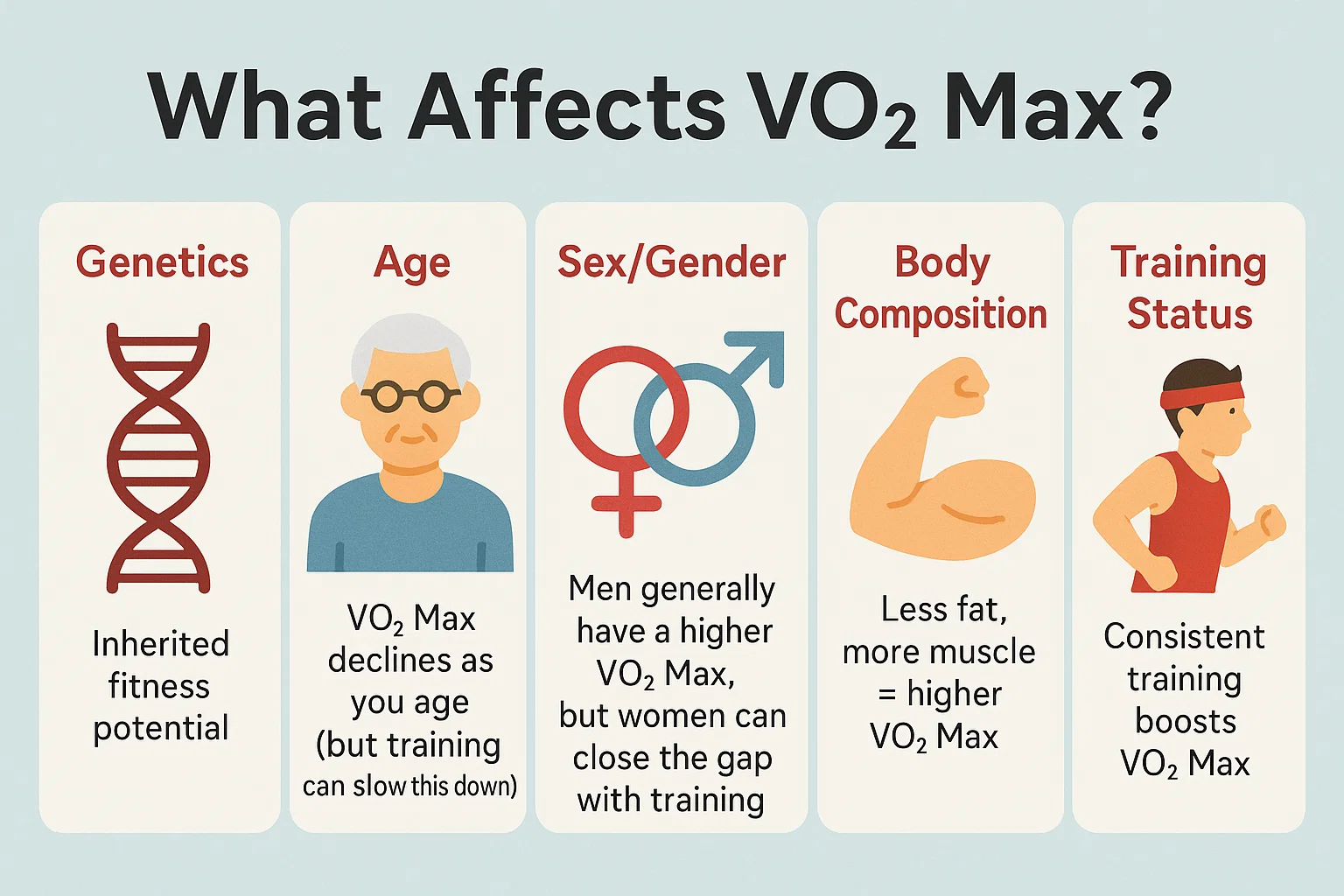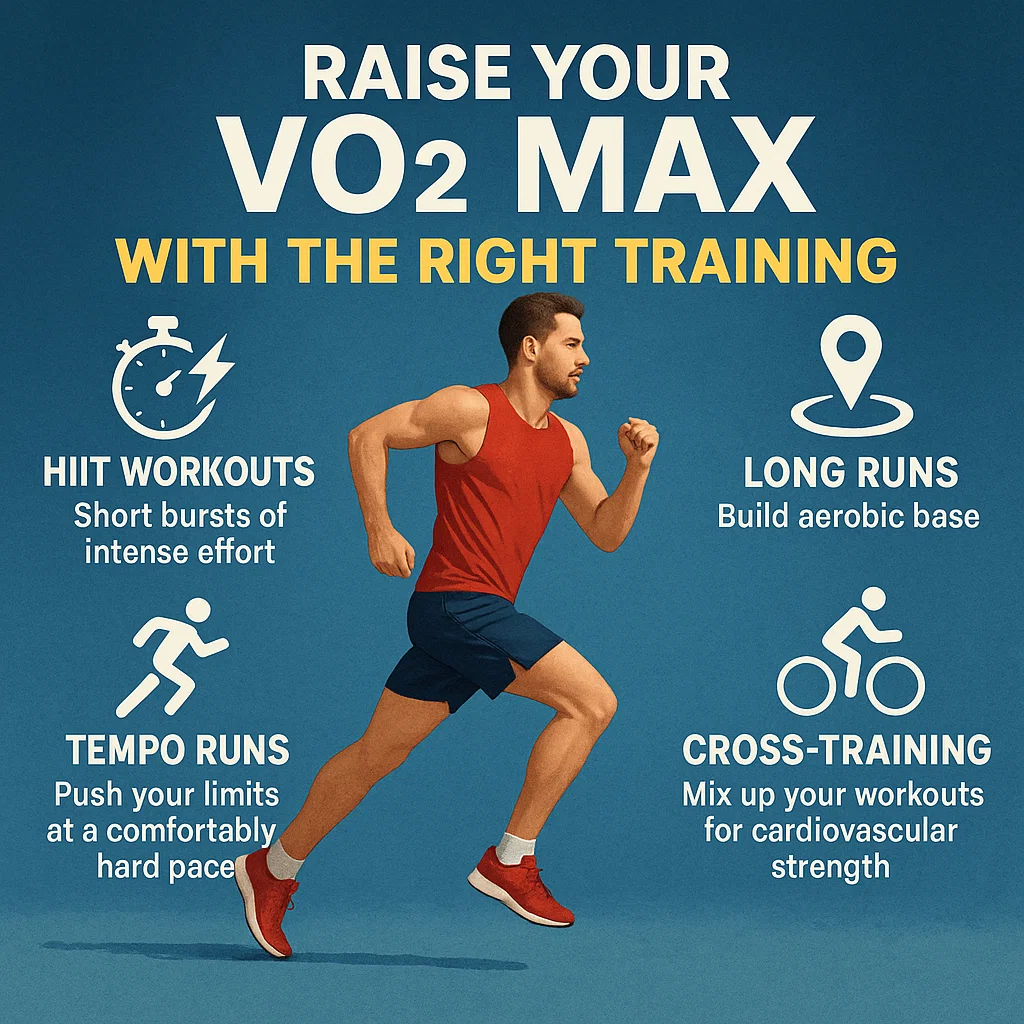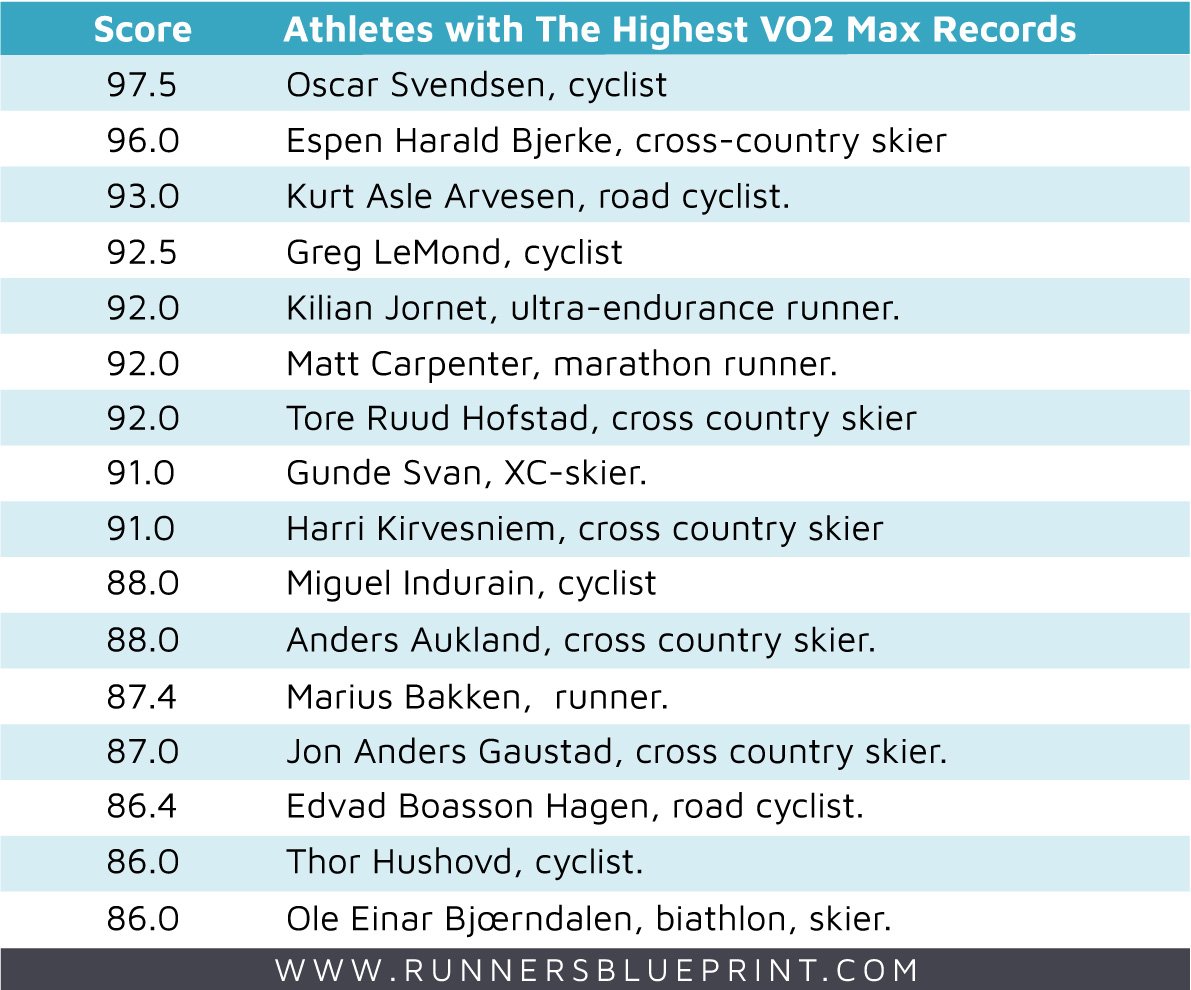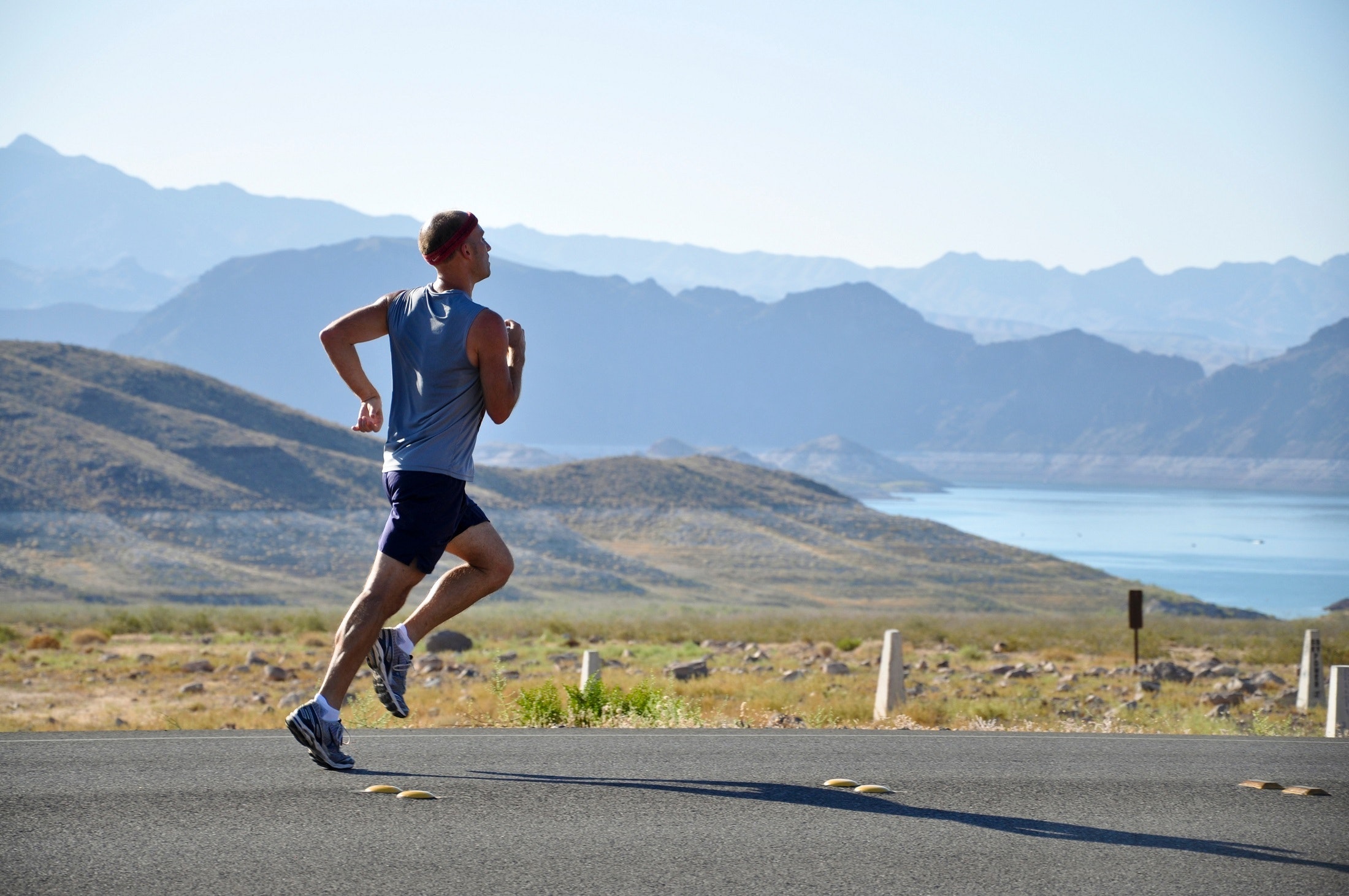Physically, here’s how it works: you breathe in oxygen, your lungs send it to your blood, and then your heart pumps that oxygen-rich blood to your muscles. Your muscles use that oxygen to create ATP – the energy your muscles need to work. V02 Max measures how well your body can deliver and use oxygen when you’re going full throttle.
You’ll usually see VO2 Max numbers in mL/kg/min (milliliters of oxygen per kilogram of body weight per minute).
So, if your VO2 Max is 50, it means your body can use 50 mL of oxygen per kilogram per minute when you’re pushing hard. The higher the number, the better your body can keep up with the demands of exercise.
Explaining VO2Max to Beginners
Let’s break it down into simpler terms:
- Your body is a factory – it needs oxygen to produce energy for exercise. VO2 Max is how much oxygen it can process in one minute when you’re running at full speed.
- Bigger lungs, stronger heart = better VO2 Max – The bigger your lungs and heart, the more oxygen you can take in and use. So, someone with a higher VO2 Max can get more oxygen to their muscles.
- Everyday analogy: Think about climbing stairs. If you’ve got a higher VO2 Max, you can climb two flights without breaking a sweat. Someone with a lower VO2 Max might huff and puff after just one. It’s all about the power of your “oxygen engine.”
- VO2 Max is just one piece of the puzzle: It’s a measure of aerobic fitness, but it’s not the whole story. A coach might say, “It’s like knowing how big your fuel tank is, but you also need to know how well your engine runs on that fuel and how fast you can use it.”
If you’re new to running, here’s the bottom line: V02 Max tells you how much oxygen your body can use when you’re working hard. Think of it like your car’s fuel intake – the bigger it is, the more fuel you can burn per minute. In running terms, the more oxygen you can take in and use, the faster and farther you can go.
But remember, VO2 Max is just one factor. How efficiently you use that fuel (your running economy) and how long you can keep going (your lactate threshold) matter, too..
My Own Take
When I first got curious about VO2 Max, I decided to take the plunge and book a lab test.
I walked into the local university’s exercise lab, strapped on a mask, and got on a treadmill.
The scientist gradually cranked up the speed and incline until I was gasping for air – it felt like I was in some sci-fi movie. But in the end, I saw my number: 52 mL/kg/min. Not bad for a 26-year-old runner who wasn’t exactly gunning for elite status.
A few years later, I grabbed a GPS watch that estimated my VO2 Max.
At first, I thought, “There’s no way this watch can measure VO2.” Turns out, these devices can’t actually measure oxygen intake – they estimate it using your heart rate and pace. I found that my watch often showed slightly higher numbers than my lab test, but it still gave me a sense of progress.
After adding in some HIIT workouts and cycling, I saw my VO2 Max improve.
After 12 weeks of doing 800m repeats and spin classes, my lab-tested VO2 Max went up by 6%.
Research backs this up – high-intensity interval training can boost VO2 Max, even for people who are already pretty fit.
But when I took a break from training (hello, holiday laziness!), I saw my numbers drop. That’s the thing with VO2 Max – it’s a reflection of your consistency.
What Affects V02 Max?
There are a few things that affect your VO2 Max. Some you’ve got no control over, and some you can definitely work on with time. Here’s the lowdown:
- Genetics: Yeah, some of this is in the genes. If your family’s packed with athletes, you might have a natural advantage. But even if you didn’t inherit superhuman VO2 Max genes, don’t sweat it. You can still improve with the right training. I didn’t exactly have the natural build of an elite runner, but with consistent effort, I’ve seen my VO2Max improve.
- Age: As we get older, VO2 Max starts to dip. A healthy 20-year-old might be sitting around 40-50 ml/kg/min, but by the time you hit your 70s, you’re looking at 20-30. Not ideal, but the good news is that staying active can slow that decline a lot. The key? Don’t let age be an excuse. Keep working, and you’ll be in better shape than most people your age.
- Sex/Gender: On average, women have a VO2 Max about 15-30% lower than men. This is because of differences in body fat, muscle mass, and hemoglobin. But guess what? If you’re a female athlete with the right training, you can close that gap to about 10%. So ladies, don’t let the numbers scare you—focus on your training.
- Body Composition: Since VO2 Max is measured per kilogram of body weight, carrying extra weight (especially fat) will lower your score. The good news? If you drop unnecessary weight (while keeping muscle), you’ll naturally boost your VO2 Max. Even Harvard Health backs this up—losing fat can help increase your VO2.
- Training Status: This one’s in your control. Regular training, especially high-intensity stuff, will raise your VO2 Max. Beginners often see huge improvements, but don’t get down if you’re a veteran runner—those small gains are still worth celebrating. It’s about consistency.
- Altitude: Training or living in the mountains can help you build up red blood cells, which can improve your VO2 Max. But heads up: when you’re up there, your VO2 Max will temporarily drop because of the thinner air. It’s all about the long haul.
- Health and Diet: Got a health issue like anemia or a lung condition? That can lower your VO2 Max. But a healthy lifestyle—good sleep, eating well, and avoiding smoking—can help you keep it up. It’s all about those solid habits.
- Day-to-Day Variation: Your VO2 Max might shift a little depending on things like how tired you are or if you’re dehydrated, but those changes won’t be huge. It’s all about consistency over time.
VO2Max and Your Running Performance
So, how does VO2 Max actually affect your running? It’s important, but it’s not the whole picture. Think of endurance like a three-legged stool:
- VO2 Max (how much oxygen you can use)
- Lactate threshold (how fast you can go before lactic acid builds up)
- Running economy (how efficiently you use oxygen)
All three are key. VO2 Max is important because it’s the size of your engine. But once your engine’s decent, you need to work on the other stuff—lactate threshold and economy.
If you want to run faster, it’s not all about pushing that VO2 Max higher and higher.
Take this: Runner A has a VO2 Max of 60, and Runner B has 50. All else equal, Runner A can go faster for the same effort. Elite runners usually have VO2 Maxes in the 70s or 80s, sometimes even higher. The world record-holders? We’re talking numbers like 96 for men and 79 for women. That’s nearly double what the average person has.
But once you’ve built up a decent VO2 Max, it’s about honing those other aspects—your lactate threshold and running economy. That’s why some of the fastest runners focus on tempo runs, long runs, and strength work. Don’t just focus on VO2Max; mix it all up.
VO2 Max in the Real World: What’s ‘Normal’ For You?
VO2 Max is a great fitness gauge, but it’s not a perfect one-size-fits-all measurement. For example, a well-trained 30-year-old guy might sit at about 50 ml/kg/min, while a top high school runner might have something in the high 60s. If you’re in your 60s, don’t worry. If you’re staying active, you might still have a VO2 Max in the 20s or 30s.
In short races (like a 5K or 10K), VO2 Max matters a lot. For marathons, it’s still important, but your lactate threshold is key. Your ability to sustain a pace over time is what separates good runners from great ones. VO2 Max will give you a solid foundation, but it’s what you do with that oxygen that counts.
The Bottom Line: VO2 Max is Key, but It’s Not Everything
VO2 Max is one of the most important factors for endurance athletes, but it’s not the only factor. You can train to improve your VO2 Max, but don’t forget about tempo runs, long runs, and strength training. It’s the combination of all these that will get you faster and more efficient.
So, don’t worry too much about your number on paper. Keep putting in the work, and your V02 Max will improve. Keep pushing, and you’ll keep improving.
How to Measure VO2Max (Lab and DIY)
So, you’re curious about how to measure VO2 Max? It’s a great question! There are two main ways to do it: the gold-standard lab test and a few DIY methods you can try on your own. Let’s break it down, starting with the lab.
Lab Testing (Gold Standard)
In a sports science lab, they measure VO2 Max directly. They slap a heart rate monitor on you and fit you with a tight mask that collects every breath.
Sounds a little sci-fi, right? You’ll run on a treadmill or ride a stationary bike while the intensity slowly increases until you’re completely gassed (usually in 10–20 minutes) (health.harvard.edu).
The mask tracks the oxygen you inhale and the carbon dioxide you exhale. When your oxygen consumption levels off, bingo—that’s your VO2 Max. This method is solid because it directly measures how much oxygen your body is using.
But here’s the catch: these lab tests aren’t cheap. They can run anywhere from $50 to $200, and they’re not something most recreational runners are doing every weekend. But if you ever find yourself in a sports physiology study or exercise medicine clinic, you could get a test done.
Field and DIY Tests
If the lab route isn’t in the cards for you, don’t sweat it—there are plenty of DIY options that’ll give you a decent estimate.
Cooper 12-Minute Run Test:
The deal is simple: run as far as you can in 12 minutes. Once you’re done, plug your distance into this formula:
V02 Max ≈ (distance in meters – 504.9) ÷ 44.73 (brianmac.co.uk).
For example, if you ran 2400 meters, it works out like this: (2400–504.9)/44.73 ≈ 42.4 ml/kg/min. Easy enough, right?
One-Mile Walk/Run Test:
Walk or run a mile as fast as you can, then immediately take your heart rate. Plug your time, heart rate, weight, and age into an online calculator. Harvard Health has a good one for estimating V02 Max.
Rockport (1-Mile) Walk Test:
Walk a mile as fast as you can, and measure your finish time and heart rate. Then, you can use the Rockport formula or an online tool to get your VO2 Max estimate.
Beep Test:
This is the “20-meter multistage fitness test” (yeah, the bleep test). You run back and forth to timed beeps. Your final level reached gives a rough idea of your VO2 Max.
Maximal Heart Rate Estimates:
Use the classic formula (220 – age) or get a little more advanced with ACSM’s tables. Combine that with your fastest pace for a quick VO2 Max guess.
Fitness Trackers/Apps:
Devices like Garmin, Fitbit, and Apple Watch use your heart rate at different paces to estimate your VO2 Max. They apply some algorithms and give you a ballpark figure.
These DIY methods aren’t as exact as a lab test, but they’ll get you close. Just make sure you keep your testing conditions consistent—flat course, well-rested, same shoes. And if you’re using a tracker, watch how your VO2Max trends over time. If it’s creeping up over a few weeks, you’re definitely improving!
Still want more V02 Max tests?
There are many methods for estimating VO2’max scores and different types of V02 max charts.
Maybe you heard a similar term but different methods.
Here are some of the most reliable ones.
These should be suitable for any fitness and lifestyle—even if you can’t walk:
- Balke VO2max test – ideal for endurance sports
- Conconi test
- Critical Swim Speed
- Harvard Step Test
- Multistage Fitness Test or Bleep test –
- Queens College Step Test
- Tecumseh Step Test
- VO2 max from a race result (time for a distance)
- VO2 max Step Test
- Wheelchair VO2max Test
- Home Step Test
How to Improve (Increase) Your VO2’Max Through Training
Alright, so now that you’ve got a VO2 Max number, let’s talk about how to raise it. If you want a higher VO2 Max, you’ve got to challenge your aerobic system. You need to push your body, and with the right training, it will adapt by improving your heart, lungs, and muscles. Here’s what works for me:
High-Intensity Interval Training (HIIT):
This is by far the most effective way to raise your VO2 Max. Short bursts of near-all-out effort push your system to its limits. For example, try 800-meter repeats or 3–5 minute hard efforts at max intensity. Harvard Health even says “HIIT is a fast and effective way to increase VO2 max, even if you’re already very active”. Aim for 2–3 interval sessions per week.
Long VO2 Max Intervals (Track Workouts):
Try this: 3 minutes at 90–95% effort, followed by 2 minutes easy jog. Repeat that 4 times for a 20-minute workout. This forces your heart and muscles to use more oxygen. It’s tough, but it’s a great workout.
Tempo Runs:
This is running at about 85–90% of your max effort—what I call a comfortably hard pace. For instance, run at this pace for 20 minutes, and you’ll see a nice improvement in how your muscles use oxygen.
Steady-State Aerobic Runs:
Don’t neglect the long, easy runs. These build your aerobic base. Think 60–90 minutes at an easy pace. This improves capillary density and mitochondrial function, indirectly supporting VO2.
Cross-Training:
Mix it up! If you’re always running, add cycling, swimming, or rowing. These activities challenge your cardiovascular system in new ways, helping boost VO2 Max.
Personal Experience:
For me, variety was key. I’ve gone through phases where I did hill sprints (20–30 second all-out efforts uphill) twice a week, and then there were times I focused on steady miles at a moderate pace. I always saw gains, but the biggest jumps in VO2 came from pushing hard. Interval training was a game-changer.
After a few weeks of HIIT, my body started to crave those high-intensity efforts. I remember one spring when I did 5×1000m intervals twice a week. My legs felt like they were spring-loaded, and my VO2 Max jumped by 5 points in 8 weeks.
There’s no magic trick—just a mix of consistent effort and pushing your limits. Every coach, no matter how many studies they quote, will tell you the same: push near your max capacity to see V02 improvements.
And don’t forget rest—overtraining can totally stall your progress.
Sample HIIT Workout:
- Warm up with an easy 10-minute jog.
- Then do 4 repeats of:
- 3 minutes at near-all-out effort
- 2 minutes easy recovery jog
- Cool down with 10 minutes of easy jogging.
This 20-minute workout hits your system hard and gets results (rei.com).
VO2 Max for Runners: Recreational vs Elite
So, let’s get this out there—VO2 Max is a big deal, but it’s not the only deal, especially for those of us who aren’t trying to land a spot on Team USA.
Recreational Runners: The Sweet Spot for Improvement
If you’re not trying to break world records (and let’s face it, most of us aren’t), don’t stress about having a VO2 Max like a pro runner. The great news? If you’re just starting out or you’re moderately trained, you’ve got a ton of room to grow.
In fact, untrained folks can see a 15-20% increase in their VO2 Max with a solid training block. That means, if your starting number is 40, with consistent effort, you could push it to 46-48. For a 30-year-old, that jump could take you from average to above-average. That’s a big win, right?
Top Athletes: Tiny Gains, Big Focus
For elite runners, they’re already at the top of the game with their VO2Max. We’re talking numbers in the 80s and 90s (ml/kg/min). Think of legends like Oskar Svendsen (cycling) with a VO2 of 97.5 and Bjørn Dæhlie (cross-country skiing) at 96.0. For women, Joan Benoit Samuelson’s 78.6 is something to marvel at.
These athletes are already pushing the limits, so every little increase in VO2 is harder to come by. They work obsessively on these tiny gains because when you’re already at the top, every edge counts.
But here’s the kicker: they’re not obsessing over the number—they’re focusing on getting stronger, faster, and better with every step.
Take a look at thee scores:
VO2 Max FAQs: Your Personal Running Game-Changer
Q: Why is my VO2 Max important?
A: VO2 Max is one of the key ways we measure how fit we are. The higher it is, the better you can perform—whether that’s running a faster 5K or pushing through a long race. It’s also tied to overall health—lower risk of heart disease, better endurance, and more. Basically, the higher your VO2 Max, the more “fit” you are. Keep that in mind when you’re out on your runs—it’s a big piece of the puzzle.
Q: Can I increase my VO2 Max if I’m older?
A: Absolutely. VO2 Max drops with age, sure, but that doesn’t mean it’s a lost cause. Staying active—especially with HIIT—can slow that decline. In fact, studies show that even folks in their 50s and 60s can still boost their VO2 Max. You might not hit those teenage numbers, but you’ll definitely feel the benefits in how you perform and how you feel. The key is consistency and staying active, no matter what age you are. Trust me, you’ve still got a lot of power in those legs.
Q: How often should I test my VO2 Max?
A: There’s no strict rule. If you’re really trying to track your progress closely, lab tests might happen every 3-6 months. But for most of us, using a fitness watch to check in weekly or monthly is enough to see trends. Personally, I liked checking mine seasonally to see how I was doing. Just don’t overdo it—your numbers might fluctuate a little from day to day. It’s normal.
Q: What if I lose weight? Does my VO2 Max change?
A: Yep, it does. Since VO2 Max is relative to body weight, losing fat can make it look better, as long as your oxygen uptake stays the same. If you shed some weight, your body has less to move around, so your VO2 Max goes up. But hey, don’t just focus on the number—how you feel is what matters most. Weight loss can definitely help, though.
Q: I don’t run much—do I need to worry about VO2 Max?
A: You don’t need to obsess over it, but it definitely matters if you’re doing any cardio—running, biking, swimming, hiking, whatever. VO2 Max is all about how efficiently your body uses oxygen during exercise, and if you’re active, it’s going to help you do all those things with less struggle. Don’t stress if you don’t track your VO2, but just know that staying active and improving it can make your workouts feel easier.
Q: Should I only focus on VO2 Max training?
A: Nah, don’t get stuck just trying to chase that number. While intervals can help, a balanced approach is the way to go. Mix in some easy runs, tempo work, and even strength training. That’s what’ll make you a better all-around runner. I learned this firsthand—when I switched to adding longer tempo runs to my training, my race times got faster, even though my VO2 plateaued. So, focus on variety, not just VO2 Max.
Q: How accurate are VO2 Max estimates on my watch?
A: They’re estimates, not perfect. Devices like the Garmin or Apple Watch usually have a 5-10% margin of error. For instance, if your real VO2 Max is 50, your watch might show 52 or 48. But honestly, that doesn’t matter too much as long as you’re consistent with the same device and setup. What matters is the trend over time—don’t sweat the small fluctuations. It’s a solid way to track progress.
Q: Can altitude training boost my VO2 Max?
A: Altitude training can help by increasing your red blood cell count, which can boost your VO2 Max once you get back to sea level. But here’s the thing—training at altitude is tough, especially at first. It’s usually something advanced athletes do. For most of us, regular training at home is enough. So, don’t stress if you can’t get to the mountains—keep working hard where you are.
Final Thoughts:
VO2 Max is a useful tool, but it’s just one part of the fitness puzzle. It’s all about how efficiently your body uses oxygen during exercise, and you can use it to train smarter and run stronger.
But here’s the thing: don’t become obsessed with the number. Use it as a gauge for progress, but don’t let it define your running journey. If it’s going up, awesome. If it stalls, take a step back and adjust your training or focus on recovery.
And above all, remember why you’re running in the first place. It’s not just about numbers or stats—it’s about enjoying the process and improving yourself over time.
Whether you’re chasing a PR or just out for a fun run with friends, let the joy of running drive you. So next time you’re pushing through a hard workout, know you’re making gains, whether you’re aware of it or not. Keep learning about your body, keep pushing forward, and most importantly—have fun with it!
Good luck, and may your VO2 Max rise along with your smile as you cross that finish line!
Further Reading on VO2 Max
To deepen your understanding of VO2 max and its importance for runners, here are some reputable organizations and studies that provide valuable insights:
- American College of Sports Medicine (ACSM): The ACSM is a leading authority on sports medicine and exercise science. Their comprehensive guidelines on exercise testing and prescription emphasize the significance of VO2 max for athletic performance. You can explore their resources on VO2 max in their position stand, available at the ACSM website.
- Journal of Sports Science and Medicine: This peer-reviewed journal features a range of studies that delve into the effects of VO2 max on performance. For instance, the article titled “The Relationship Between VO2 Max and Running Performance” discusses how VO2 max levels correlate with various race performances.
- British Journal of Sports Medicine: This journal regularly publishes research on exercise physiology and training methods. A notable study, “How to Measure and Improve Your VO2 Max”, provides insights into measuring VO2 max and training strategies to enhance it.
- Mayo Clinic: The Mayo Clinic offers accessible information on VO2 max and its implications for cardiovascular health. Their article on “Exercise and Heart Health” discusses the role of aerobic exercise and VO2 max in maintaining heart health.
- Runner’s World: This popular resource provides articles specifically focused on running and performance metrics, including VO2 max. Check out their article, “How to Boost Your VO2 Max” for practical tips and insights.


